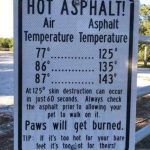HEATSTROKE IN PETS
As the temperatures and humidity levels rise, veterinary hospitals and clinics are seeing more and more, cases of heatstroke (hyperthermia) in pets. In dogs, the body temperature rises to such a level, that they are unable to release the heat, and cool their bodies down naturally, through panting or laying on a cooled surface. One should be concerned if their pet’s body temperature rises above 104.9°.
As humans, we sweat to release heat. Dogs, really do NOT sweat. Yes, dogs do have a few sweat glands in the footpads. However, the footpads only minimally aid in releasing heat.
Heatstroke tends to occur in pets that have been exposed to extreme temperatures and/or had long-term exposure to heat. As pet owners, we need to be more aware, and vigilant about our pet’s risk of exposure to heat. Allowing your pet to sit outdoors for long periods of time, leaving your pet in a hot vehicle, and/or exercising them too long outdoors, may result in heatstroke.
Without immediate attention, heatstroke may cause serious complications, or may even result in death. The pet’s temperature and length of exposure to heat, are two factors that may determine the seriousness and damage to the animal.
SIGNS OF HEATSTROKE (HYPERTHERMIA) IN PETS
It’s extremely important to understand the signs of heatstroke in your pet. Even mild heatstroke should warrant the attention of your veterinarian. Some of the signs to look out for include, but may not be limited to the following:
- Heavy panting
- Rapid breathing
- Bright red gums or tongue
- Skin hot to the touch
- Fast heart rate
- Balance issues/dizziness
- Pale or blue gums with long-term heat exposure
- Severe dehydration
- Dilated pupils
- Muscle tremors
- Lethargy
- Uncontrolled urination or bile movements
- Collapse or coma
FACTORS THAT MAY MAKE YOUR PET MORE VULNERABLE
A number of factors may also make your pet more susceptible to heatstroke:
- Age – puppies and older dogs are more susceptible
- Physical condition – out of shape dogs are more vulnerable
- Weight – overweight pets are more likely to suffer from heatstroke
- Medical conditions – animals with compromised health conditions are more likely to suffer
- Environment – as mentioned earlier, exposure to heat and climate changes
- Water access – pets who have little, or no access to water are more vulnerable
- Occurrence – if your pet has suffered heatstroke prior, they may be more susceptible
TREATMENT FOR HEATSTROKE
As mentioned earlier, if you believe that your pet is suffering from heatstroke, try to take steps to GRADUALLY, lower their temperature.
- Seek shade/shelter
- Carry the pet, if needed
- Cool the pet down with cool water, NOT ice cold. Use a sponge bath technique over full immersion.
It is important to seek medical attention, even in mild cases. Keep in mind, complications may not be immediate. Consult your veterinarian to treat any pup who has suffered from heatstroke.
IT’S ALL ABOUT PREVENTION
As pet owners, we want Fido to come along on all of our outdoor adventures. We love when they jog with us, play fetch, or even when we take them on a road trip. It’s up to you to stay mindful of the temperatures, and limit your pet’s exposure to the heat.
You can safely enjoy any, or all of these activities, with your pets through prevention and awareness:
- Limit outdoor activities to cooler times of the day
- Always provide your pet with plenty of fresh water
- Allow your pet to rest frequently
- Provide shade
- NEVER, not even for a moment, leave your pet in a hot car
- Take action immediately if you see your pet exhibiting signs of heatstroke
For more great pet related topics from the doctors and staff at Independence Vet Clinic, click here!To learn more about heatstroke in pets, see this article from PetMD.











